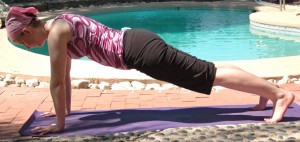 It is hard to hide in the plank position. As a teacher it is important for me to know the strengths and weaknesses of the students who come to my classes regularly. Every body has different needs even though everyone is doing to same poses; it is my job to guide students towards the work they need as an individual.
It is hard to hide in the plank position. As a teacher it is important for me to know the strengths and weaknesses of the students who come to my classes regularly. Every body has different needs even though everyone is doing to same poses; it is my job to guide students towards the work they need as an individual.
When someone new comes to class I invariably use plank position to glean information on their core tone or lack thereof. We want a solid trunk. The muscles of the pelvic floor, the abdominal muscles and a bunch of spinal extensor muscles are responsible for a center that can stabilize as much as it can move. Walking, standing or doing yoga—we want a spine that can both be solid and supple.
The alignment of a student’s head in plank position gives a teacher much of the information they need to know about that student’s core. The ability to keep the ears up in line with the shoulders in plank position requires a small curve in the lower spine and proper tone of the muscles in the abdomen and pelvis.
If the ears can’t stay in line with the shoulders in the horizontal plane it is not the fault of the head and neck, whose poor muscles suffer terribly in this environment. The blame lies lower in the trunk where the pelvic muscles, the abdominals, and the spinal extensors lack the balance and strength to support the head.
The journey from plank to the floor compounds this head and neck issue in a big way so if a new student shows up I will usually do plank right away and lower straight down to the floor, watching the new students head. If it moves faster than everything else in the body I will probably spend a good portion of the class working on and talking about the transverse abdominis, the first muscle I get people to start working in their search for a balanced body.
